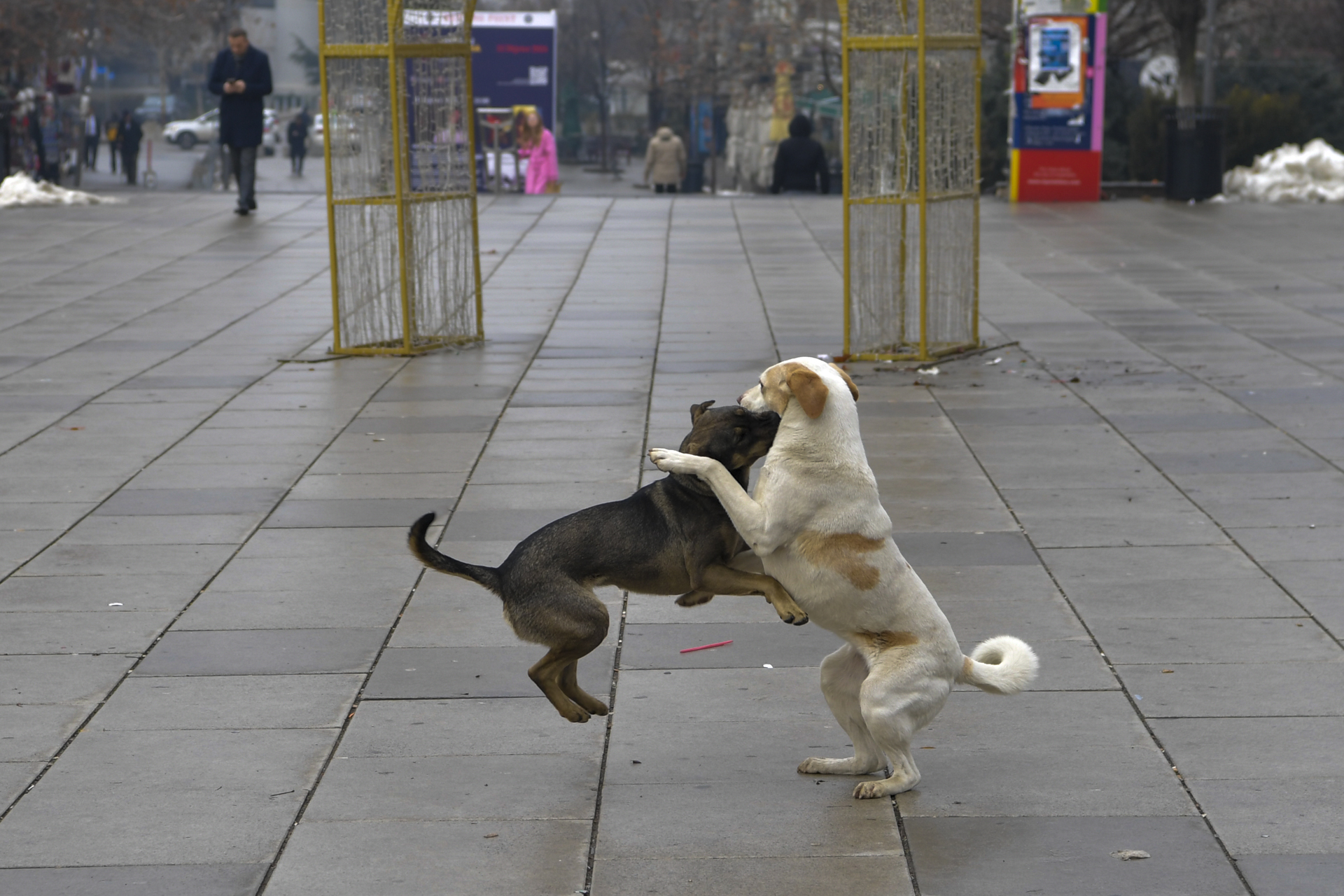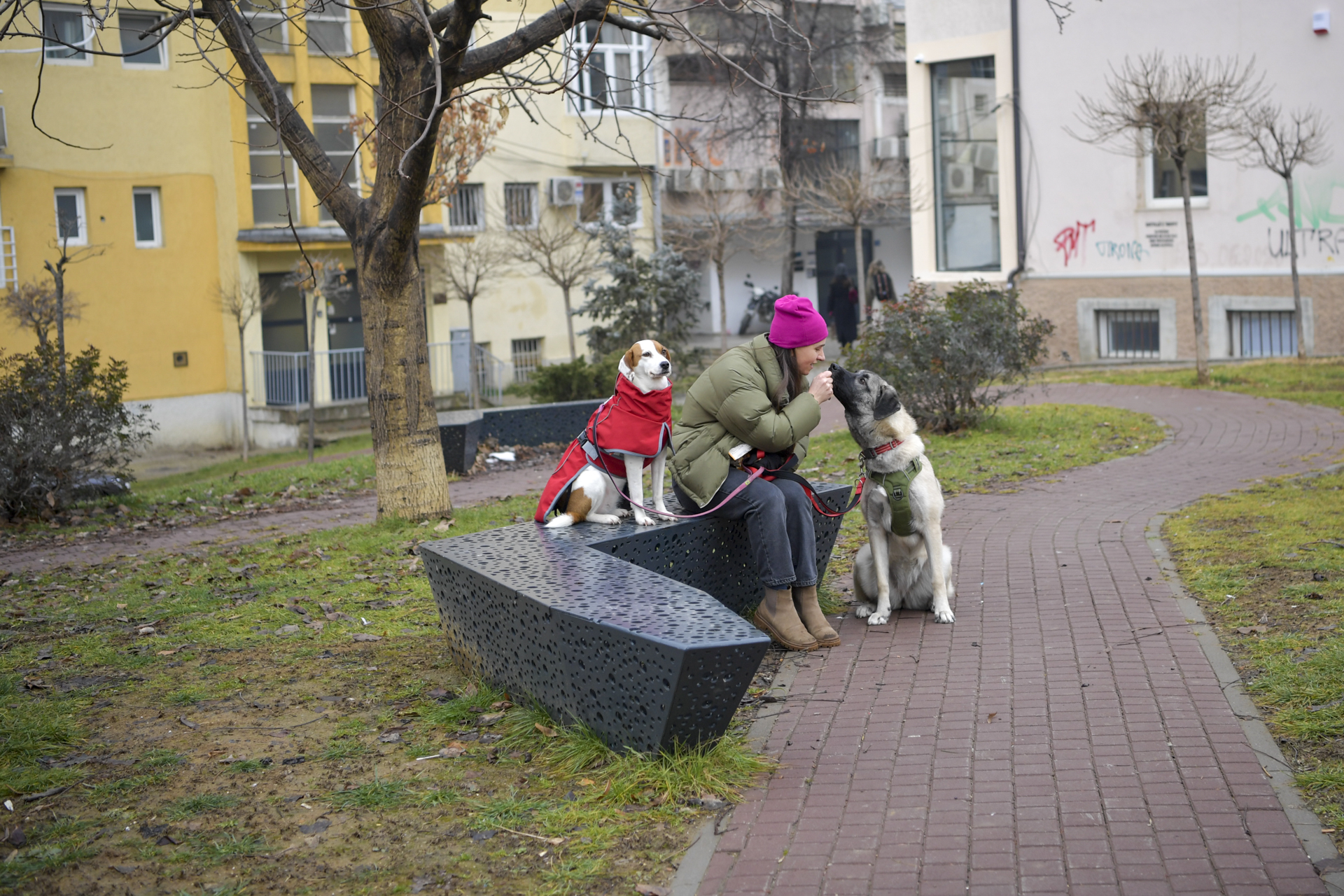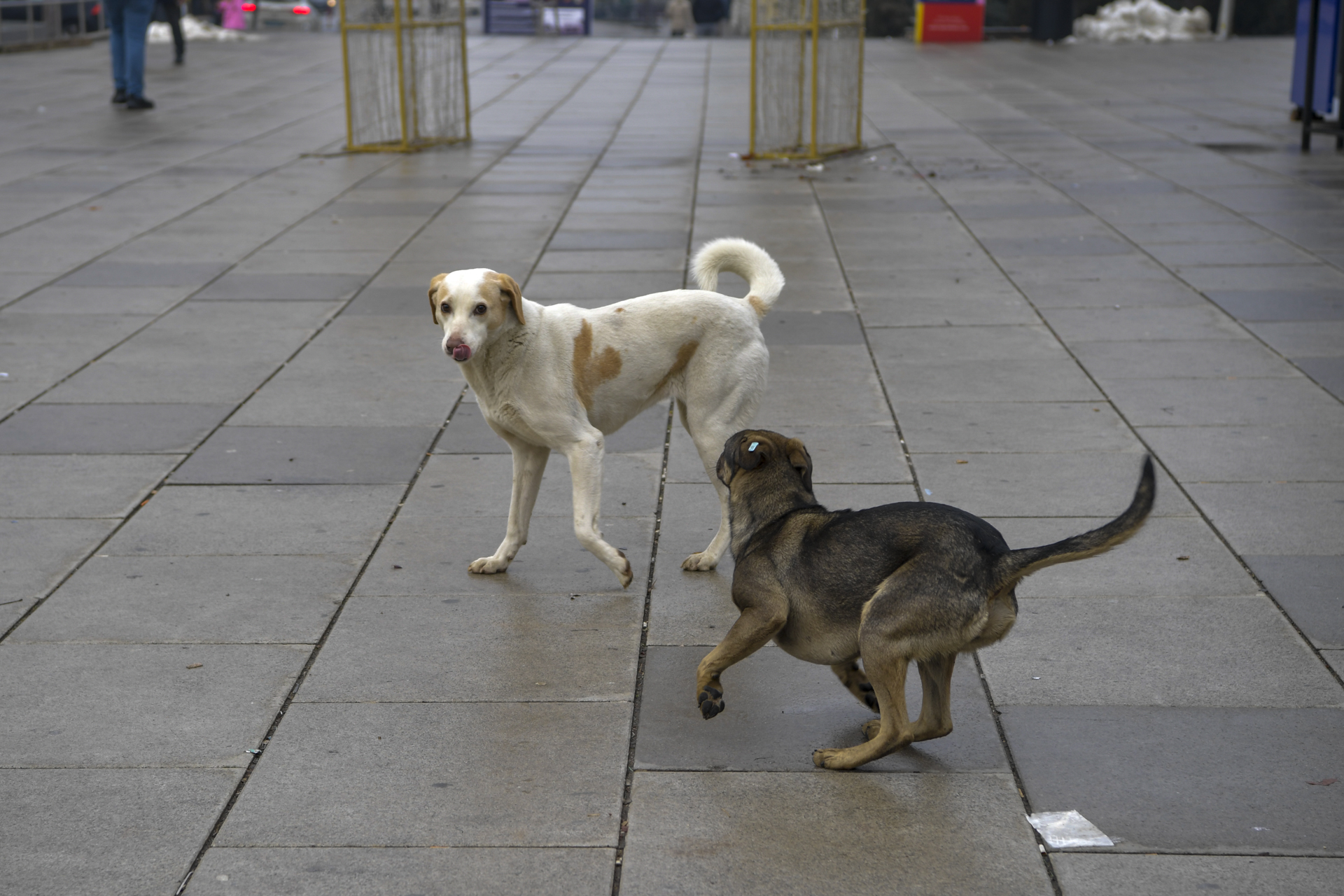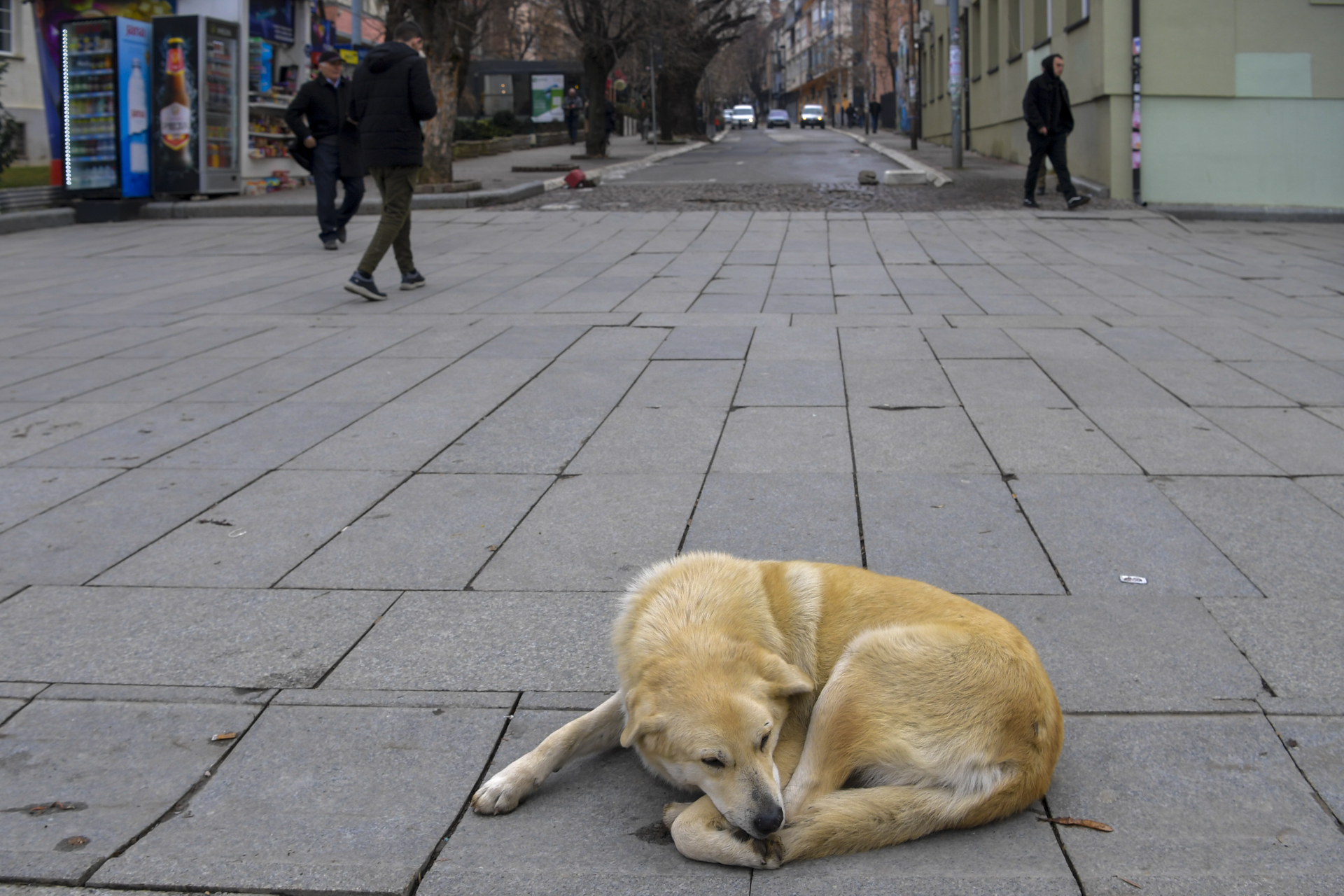In the past months, repeated incidents of dog attacks in Prishtina have been publicized in the media through photos and videos, sparking heated online debates and calls for immediate action to remove the dogs from the streets. One particular area of Prishtina became a hotbed of controversy, the University Clinical Center of Kosovo (UCCK), where it is reported that 60-100 dogs live. UCCK’s director of neurology, Edmond Komoni, was attacked by the dogs in October 2024, caught live on video.
Kumrije Shabani-Ramadani, an anesthesia technician and municipal assemblywoman from the Democratic Party of Kosovo (PDK), reacted on Facebook, where it caught further media attention. She addressed Prishtina Mayor Përparim Rama, saying that “It is unacceptable that health professionals and citizens live in fear for their lives and safety due to the failure to manage this problem.” Furthermore, she asked Rama “to take immediate and concrete measures to protect citizens from these dangers. Bites from stray dogs can no longer be a common occurrence in our city.”
According to UCCK, 112 cases of bodily harm from dogs were recorded from January to September 2024, making the calls for relevant institutions to resolve the issue more urgent.
However, while reports of dog attacks in Prishtina have punctured local headlines, a deeper examination of why these dogs are on the streets in the first place — and how the municipality’s responses have fallen short — is missing.
The city’s response
Estimates of how many stray dogs live in Prishtina range from just over 4,000 to 10,000.
Whatever the exact number may be, since Rama became mayor in 2021, he has pledged to take tougher measures aimed at reducing it. The municipality announced the expansion of sterilization campaigns and plans for the Stray Dog Treatment Center in 2022 and launched a program offering 50 euros in monthly incentives for adoptions of up to five dogs in June 2023. These efforts have been met with skepticism and outrage from animal welfare activists, who argue that the schemes prioritize publicity over meaningful solutions.
One of them is 24-year-old Fiona Rrecaj, who cared for a stray for nine years before it was taken by municipal workers as part of an effort to reduce the number of dogs on the streets.
“They treat these animals as a nuisance, not as living beings deserving of care,” she said Rrecaj’s dog was later found in dire conditions at a shelter, unvaccinated and unfed — a reflection of the system’s failings.

Prishtina Mayor Përparim Rama has pledged to reduce the stray dog population. Photo: Atdhe Mulla / K2.0
For every incident that makes the news, countless others remain untold — stories not of attacks, but of cruelty, neglect and systematic mistreatment of creatures too often framed as the aggressors. This is where the real story begins: a tale not of stray dogs threatening public safety but of how these animals became scapegoats for deeper structural problems. How a cycle of abandonment, ineffective governance and media fearmongering has turned these dogs into victims of a broken system.
Adopters share their stories
46-year-old Valbonë Mustafa rescued two dogs, who she named Bubu and Picrra, in June 2023 and May 2024, respectively. Her experiences shed light on both the challenges and rewards of adopting strays. Bubu, who Mustafa had cared for while she was a stray at Gërmia Park, was sterilized as part of a municipal program. But when Bubu was returned to Gërmia Park, Mustafa noticed that she had lost significant weight and refused to eat.

Valbonë Mustafa, who adopted two dogs, sees context-less social media posts as one of the factors shaping negative public perceptions about dogs. Photo: Atdhe Mulla / K2.0
Concerned for her health, Mustafa took her in, despite advice that stray dogs struggle to adapt to the indoors. “It didn’t take more than two days for Bubu to feel at home and start to recover,” said Mustafa, who lives in Prishtina and works as a translator.
Mustafa pointed to the media as one of the main factors impacting the stigma around stray dogs. “Some find stray dogs unclean and fear diseases they might spread. But the media, especially social media sharing images of dog attacks without explaining what triggers them to attack or how to act in such situations, has spread fear amongst the public and has had a major impact on how we perceive dogs as society,” said Mustafa.
Overall, animal rights activists have been disappointed by the outcome.
Mustafa adopted Bubu and Picrra through legal procedures with the municipality, though not as part of the city-wide 50 euro scheme, which was introduced as an incentive to encourage citizens to adopt, and framed as a humane and community-driven solution. Bajram Gecaj, an advisor in the mayor’s cabinet, said in an email to K2.0 that the municipality has successfully facilitated the adoption of 600 dogs so far, attributing this figure to the 50 euro monthly adoption scheme and the Stray Dog Treatment Center’s operations.
“We aim to take all stray dogs from the streets and adopt them; we would appreciate if that’s done by citizens individually, and we do appeal to everyone that loves dogs to help us in this,” said Gecaj. “Nevertheless, we have a commission of three members that initially do inspect the site where the dogs are to be adopted, while we also have the other commission of three that do from time to time inspect the wellbeing and the treatment of dogs by the adoptees.”
Overall, however, animal rights activists have been disappointed by the outcome. They are also skeptical of the claim that 600 dogs have been adopted. According to a survey of 623 households in the Municipality of Prishtina, conducted in fall 2022 and spring 2023 by the Animal Rights Foundation, an organization that seeks to advance animal welfare through legal reform and increased public awareness, a large majority of respondents said they would not adopt a dog.
Moreover, many have questioned the speed of the adoption process — some dogs were reported as “adopted” within just 24 hours — and the absence of proper checks to ensure the dogs were placed in safe and caring homes. The concern is that the added financial incentive risked incentivizing individuals to adopt dogs for profit rather than out of genuine care, potentially worsening the possibility of finding a long-term solution to the issue.
“Except for two adopters that have adopted a dozen dogs and they were advertised on social media and TV, we don’t know who the other adopters are and whether they meet the adoption criteria or not. Most importantly, we still don’t know where our stray dogs are,” said Mustafa. The Animal Rights Foundation says that some individuals were paid to “adopt” 20-50 dogs. This, the foundation says, amounts to the creation of unregulated shelters.
“Many stray dogs that I have been feeding for years, and have organized vaccinations and neutering for, are missing. I have contacted the officials in charge with photos of each dog attached but their response was not relevant to my request. Many animal rights activists have gone through similar experiences,” added Mustafa.
Adriana Bajramaj from Protect Me Kosova, an animal rescue organization, also criticized the approach. “We have the impression that they have not consulted people who really know the situation of stray dogs and that they have built this shelter [the Stray Dog Treatment Center] for political reasons and not to really HELP the dogs,” Bajramaj said in a text message. She further emphasized that offering 50 euros a month to adopters doesn’t help. “A person who really loves animals will adopt one without being paid, and there’s no shortage of choice — you just have to go out on the street,” she said.
Gecaj sought to shift criticism away from the current municipal government, arguing that Rama’s cabinet invested 4 million euros toward the issue, while the previous municipal administration had only allocated 70,000 euros in the eight years of their two-term mandate. According to Gecaj, on the federal level, “1.3 million euros was the largest sum allocated in the past for the treatment of stray dogs in this country, during the [Ramush] Haradinaj government. Therefore, the criticism should indeed be directed toward those that are doing nothing, not us.”
He further reiterated that he wanted to make it “clear” that the municipality has adopted 600 dogs through the 50 euro scheme.
He further reiterated that he wanted to make it “clear” that the municipality has adopted 600 dogs through the 50 euro scheme.
These claims have done little to quell skepticism among activists and residents. Critics continue to highlight the lack of public data to verify these adoptions, as well as the municipality’s refusal to allow regular inspections of the shelter. For Mustafa and other activists, the lingering question remains: Where are these 600 adopted dogs?
Other animal rights activists, like Argjenta Doçiqi, shared Mustafa’s concerns. Doçiqi, has organized rescues for strays for over a decade, finding them homes abroad in countries like the U.S. or the U.K.. She was invited to run the newly opened Stray Dog Treatment Center but declined the opportunity, believing that she and the municipality did not see eye-to-eye on how it should be handled.
Doçiqi sees relying on adoptions in a country where such adoptions are uncommon as misguided. In her view, the shelter “should have been used solely for spaying, neutering and vaccinating dogs before returning them to their original territories,” rather than preparing dogs for adoptions.
“For the mayor to claim that there are ‘families’ ready to ‘adopt’ stray dogs is an insult to everyone who has worked tirelessly in dog rescue in Kosova and the surrounding countries,” said Doçiqi.
“Our biggest challenge as a rescue operation has always been finding paid fosters to keep our dogs safe while we cover all veterinary care, food and international adoption arrangements. For the mayor to claim that there are ‘families’ ready to ‘adopt’ stray dogs is an insult to everyone who has worked tirelessly in dog rescue in Kosova and the surrounding countries,” said Doçiqi. “If these adoptions have happened, why there isn’t any happy adoption stories, [or] for these dogs to be seen anywhere?”
A rushed process
Rrecaj’s experience casts further doubt on the municipality’s adoption process. For nine years, she cared for Bombica, a neighborhood dog who she describes as “gentle, affectionate and well-cared for by myself and other neighbors.” Then, municipal workers abruptly took Bombica to the new center, supposedly to prepare her for adoption.
Rrecaj says she also saw Zorro, a different neighborhood dog she had cared for, in the background of a video showing Rama at the shelter. “You could see how scared Zorro was, shivering and visibly terrified, while Përparim smiled in the video,” she said.
When Rrecaj located Bombica in a shelter, she was horrified by what she found. “The conditions were awful. The dogs were surrounded by electric fencing, and they were feeding them dry bread that had been soaked in water. It was heartbreaking to see how they were treated,” she recounted.
The situation took another turn when Rrecaj learned that Bombica had been relocated to a private adopter who works with the municipality. “Now she’s with another adopter who has over 50 dogs,” Rrecaj explained. While the new environment was slightly better than the shelter, Rrecaj noted that the stress of being around so many other dogs was taking a toll on the dog she had cared for. “Seeing the dogs fighting for dominance is heartbreaking, and I know she’s not truly happy there,” she said.
Rrecaj also recently took in a malinois she named Bambi. She attempted to contact the municipality about adopting Bambi through the 50 euro incentive but never heard back, even after offering the officials to visit her apartment to ensure that Bambi was in a safe and caring environment.
“I’m deeply concerned that these dogs are either being sent to horrible places or, worse, may not even be alive anymore. The municipality’s refusal to address these issues only makes things more difficult, and I’m terrified that more dogs are disappearing without proper care or oversight,” said Rrecaj.

Animal rights activists are skeptical of the municipality’s initiative to remove stray dogs from the streets and promote adoption. Photo: Atdhe Mulla / K2.0
While the municipality told K2.0 that they welcomed initiatives from citizens, Rrecaj’s account paints a different picture.
Elza Ramadani, founder of the Animal Rights Foundation, shares Rrecaj’s frustration and emphasizes the municipality’s failure to address the core issues. “The financial incentive for adoptions, while well-intentioned, has led to unethical practices where individuals prioritize monetary gain over animal welfare,” Ramadani said. She raised concerns about the lack of oversight, transparency and proper checks to ensure dogs are placed in safe homes.
“Up to now, some officials have posted on their social media that around 500 dogs were taken from the streets and went directly to ‘adopters.’ The swift procedures of adoption tell us something is wrong,” she added.
Ramadani and her foundation requested official data from the municipality regarding the adoptions, but she says that municipal officials have delayed providing the requested information and have not supplied a full list of adopted dogs and adopters. She also criticized the municipality for failing to adhere to proper procedures regarding the adoption process.
The Stray Dog Treatment Center in Hajvali officially opened in 2024, part of the municipality’s expanded efforts to manage the growing stray dog population. Marketed as a facility to sterilize, vaccinate and prepare dogs for adoption, the shelter quickly came under fire from animal rights activists. Ramadani criticized the lack of transparency in its operations. “The adoption process, by law, is supposed to go through the shelter, but this isn’t happening,” she explained. “We’ve been requesting, since its opening, to visit the shelter twice a week to monitor the dogs and assist where needed, but no one has responded. This lack of cooperation and transparency proves that the approach is neither humane nor sustainable in reducing the stray population.”
Ejupi, who works with children, believes that solving the issue begins with educating children on how to treat dogs.
Every day, 35-year-old Blerta Ejupi visits and feeds the dogs who live in Taukbashqe Park. She has received help from Prishtina Dog Shelter, a nongovernmental organization that provides veterinary and adoption assistance for stray dogs, to take care of the growing population of strays.
Ejupi, who works with children, believes that solving the issue begins with educating children on how to treat dogs. She also echoes Ramadani’s criticism regarding the new shelter. “There should be ways to teach these kids empathy! At home and school! It’s sad that at this point it should be mandatory — maybe even visits to the shelters,” Ejupi said.

Both activists and municipality officials believe that central government involvement is key to solving this problem. Photo: Atdhe Mulla / K2.0
Mentor Gashi, who runs Prishtina Dog Shelter, believes that efforts from the municipality won’t truly solve anything, no matter how much funds they commit to finding a true home for stray dogs. “Here, there are so many compassionate people who feed and take care of the dogs, but all this is only symbolic unless we as a society change our perspective,” said Gashi.
Despite differing views on the municipality’s efforts, activists and officials agree that solving the stray dog issue requires federal involvement. Gecaj emphasized, “The municipality alone cannot solve this issue; it requires coordinated efforts and resources from the government.” Ramadani echoed this, stating, “The involvement of Prime Minister Kurti and the central government is essential for systemic change,” pointing towards the national strategy as a necessary but neglected framework. Activists like Doçiqi added, “This cannot be addressed by one municipality alone; it requires a nationwide approach.”
The question now is not whether change is needed, but how long these dogs — and the city — must wait for an impactful and long-lasting resolution.
Finding a true solution for these beings remains out of reach unless the central government steps in with meaningful commitment and funding. The question now is not whether change is needed, but how long these dogs — and the city — must wait for an impactful and long-lasting resolution.
“The dogs are there because of the people, they are clearly the victims of the people and not the other way round. They haven’t asked for anything, and they suffer much more every day than the people who are scared of them,” said Bajramaj.
Feature image: Atdhe Mulla / K2.0.
Editor’s note (February 18, 2025): This article has been updated to correct details about Bombica and Zorro, two neighborhood dogs Fiona Rrecaj cared for. The original version included details about Zorro which should have been attributed to Bombica.
 Want to support our journalism? Become a member of HIVE or consider making a donation. Learn more here.
Want to support our journalism? Become a member of HIVE or consider making a donation. Learn more here.





